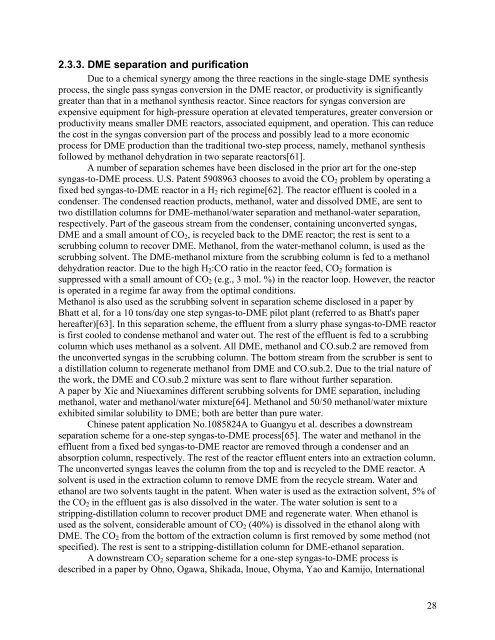Novel Design of an Integrated Pulp Mill Biorefinery for the ...
Novel Design of an Integrated Pulp Mill Biorefinery for the ...
Novel Design of an Integrated Pulp Mill Biorefinery for the ...
You also want an ePaper? Increase the reach of your titles
YUMPU automatically turns print PDFs into web optimized ePapers that Google loves.
2.3.3. DME separation <strong>an</strong>d purification<br />
Due to a chemical synergy among <strong>the</strong> three reactions in <strong>the</strong> single-stage DME syn<strong>the</strong>sis<br />
process, <strong>the</strong> single pass syngas conversion in <strong>the</strong> DME reactor, or productivity is signific<strong>an</strong>tly<br />
greater th<strong>an</strong> that in a meth<strong>an</strong>ol syn<strong>the</strong>sis reactor. Since reactors <strong>for</strong> syngas conversion are<br />
expensive equipment <strong>for</strong> high-pressure operation at elevated temperatures, greater conversion or<br />
productivity me<strong>an</strong>s smaller DME reactors, associated equipment, <strong>an</strong>d operation. This c<strong>an</strong> reduce<br />
<strong>the</strong> cost in <strong>the</strong> syngas conversion part <strong>of</strong> <strong>the</strong> process <strong>an</strong>d possibly lead to a more economic<br />
process <strong>for</strong> DME production th<strong>an</strong> <strong>the</strong> traditional two-step process, namely, meth<strong>an</strong>ol syn<strong>the</strong>sis<br />
followed by meth<strong>an</strong>ol dehydration in two separate reactors[61].<br />
A number <strong>of</strong> separation schemes have been disclosed in <strong>the</strong> prior art <strong>for</strong> <strong>the</strong> one-step<br />
syngas-to-DME process. U.S. Patent 5908963 chooses to avoid <strong>the</strong> CO2 problem by operating a<br />
fixed bed syngas-to-DME reactor in a H2 rich regime[62]. The reactor effluent is cooled in a<br />
condenser. The condensed reaction products, meth<strong>an</strong>ol, water <strong>an</strong>d dissolved DME, are sent to<br />
two distillation columns <strong>for</strong> DME-meth<strong>an</strong>ol/water separation <strong>an</strong>d meth<strong>an</strong>ol-water separation,<br />
respectively. Part <strong>of</strong> <strong>the</strong> gaseous stream from <strong>the</strong> condenser, containing unconverted syngas,<br />
DME <strong>an</strong>d a small amount <strong>of</strong> CO2, is recycled back to <strong>the</strong> DME reactor; <strong>the</strong> rest is sent to a<br />
scrubbing column to recover DME. Meth<strong>an</strong>ol, from <strong>the</strong> water-meth<strong>an</strong>ol column, is used as <strong>the</strong><br />
scrubbing solvent. The DME-meth<strong>an</strong>ol mixture from <strong>the</strong> scrubbing column is fed to a meth<strong>an</strong>ol<br />
dehydration reactor. Due to <strong>the</strong> high H2:CO ratio in <strong>the</strong> reactor feed, CO2 <strong>for</strong>mation is<br />
suppressed with a small amount <strong>of</strong> CO2 (e.g., 3 mol. %) in <strong>the</strong> reactor loop. However, <strong>the</strong> reactor<br />
is operated in a regime far away from <strong>the</strong> optimal conditions.<br />
Meth<strong>an</strong>ol is also used as <strong>the</strong> scrubbing solvent in separation scheme disclosed in a paper by<br />
Bhatt et al, <strong>for</strong> a 10 tons/day one step syngas-to-DME pilot pl<strong>an</strong>t (referred to as Bhatt's paper<br />
hereafter)[63]. In this separation scheme, <strong>the</strong> effluent from a slurry phase syngas-to-DME reactor<br />
is first cooled to condense meth<strong>an</strong>ol <strong>an</strong>d water out. The rest <strong>of</strong> <strong>the</strong> effluent is fed to a scrubbing<br />
column which uses meth<strong>an</strong>ol as a solvent. All DME, meth<strong>an</strong>ol <strong>an</strong>d CO.sub.2 are removed from<br />
<strong>the</strong> unconverted syngas in <strong>the</strong> scrubbing column. The bottom stream from <strong>the</strong> scrubber is sent to<br />
a distillation column to regenerate meth<strong>an</strong>ol from DME <strong>an</strong>d CO.sub.2. Due to <strong>the</strong> trial nature <strong>of</strong><br />
<strong>the</strong> work, <strong>the</strong> DME <strong>an</strong>d CO.sub.2 mixture was sent to flare without fur<strong>the</strong>r separation.<br />
A paper by Xie <strong>an</strong>d Niuexamines different scrubbing solvents <strong>for</strong> DME separation, including<br />
meth<strong>an</strong>ol, water <strong>an</strong>d meth<strong>an</strong>ol/water mixture[64]. Meth<strong>an</strong>ol <strong>an</strong>d 50/50 meth<strong>an</strong>ol/water mixture<br />
exhibited similar solubility to DME; both are better th<strong>an</strong> pure water.<br />
Chinese patent application No.1085824A to Gu<strong>an</strong>gyu et al. describes a downstream<br />
separation scheme <strong>for</strong> a one-step syngas-to-DME process[65]. The water <strong>an</strong>d meth<strong>an</strong>ol in <strong>the</strong><br />
effluent from a fixed bed syngas-to-DME reactor are removed through a condenser <strong>an</strong>d <strong>an</strong><br />
absorption column, respectively. The rest <strong>of</strong> <strong>the</strong> reactor effluent enters into <strong>an</strong> extraction column.<br />
The unconverted syngas leaves <strong>the</strong> column from <strong>the</strong> top <strong>an</strong>d is recycled to <strong>the</strong> DME reactor. A<br />
solvent is used in <strong>the</strong> extraction column to remove DME from <strong>the</strong> recycle stream. Water <strong>an</strong>d<br />
eth<strong>an</strong>ol are two solvents taught in <strong>the</strong> patent. When water is used as <strong>the</strong> extraction solvent, 5% <strong>of</strong><br />
<strong>the</strong> CO2 in <strong>the</strong> effluent gas is also dissolved in <strong>the</strong> water. The water solution is sent to a<br />
stripping-distillation column to recover product DME <strong>an</strong>d regenerate water. When eth<strong>an</strong>ol is<br />
used as <strong>the</strong> solvent, considerable amount <strong>of</strong> CO2 (40%) is dissolved in <strong>the</strong> eth<strong>an</strong>ol along with<br />
DME. The CO2 from <strong>the</strong> bottom <strong>of</strong> <strong>the</strong> extraction column is first removed by some method (not<br />
specified). The rest is sent to a stripping-distillation column <strong>for</strong> DME-eth<strong>an</strong>ol separation.<br />
A downstream CO2 separation scheme <strong>for</strong> a one-step syngas-to-DME process is<br />
described in a paper by Ohno, Ogawa, Shikada, Inoue, Ohyma, Yao <strong>an</strong>d Kamijo, International<br />
28

















